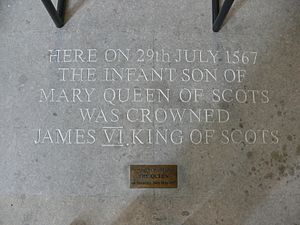Coronation of James VI facts for kids
| Date | 29 July 1567 |
|---|---|
| Venue | Church of the Holy Rude |
| Location | Scotland |
| Type | Royal coronation |
| Participants | James VI, various dignitaries and guests |

On July 29, 1567, James Stewart became King of Scotland. He was the son of Mary, Queen of Scots and Lord Darnley. James was crowned at the Holy Rude Kirk in Stirling. He was only 13 months old at the time. Adam Bothwell, the Bishop of Orkney, led the ceremony.
Why James Became King
Mary, Queen of Scots, James's mother, was held in Lochleven Castle. This happened after she surrendered at the Battle of Carberry Hill. On July 24, she was made to sign papers. These papers said she would give up her crown to her son. This meant James would become the new king.
On July 28, a legal paper was written. It said that Mary's keeper, William Douglas, was not there when she signed. He also said he didn't know about it. Douglas offered to take Mary to Stirling Castle for James's coronation. But she said no.
The Coronation Ceremony
On July 26, messages were sent to towns across Scotland. They announced the upcoming coronation. Special robes were also ordered for the young king. Many important people supported James. 62 nobles and 13 representatives from towns signed an agreement. They promised to support James as king. They also agreed to defend the new Protestant church in Scotland.
On July 27, Scottish lords and the Privy Council traveled to Stirling. They brought the Honours of Scotland from Edinburgh Castle. These are the special royal items: the crown, sceptre, and sword.
On July 29, Annabell Murray, Countess of Mar brought Prince James to the Holy Rude Kirk. The ceremony lasted three hours. His mother, Mary, had been crowned in Stirling Castle in 1543.
At the start of the ceremony, Lord Lindsay and Lord Ruthven spoke. They swore that Mary had given up her crown willingly.
Bishop Adam Bothwell put special oil on the king. This is called anointing. Then, the Earl of Atholl placed the crown on James's head.
An English official named Henry Middlemore was there. He sent a report to Elizabeth I, the Queen of England. He said the young prince was crowned by the Bishop of Orkney. John Knox, a famous preacher, gave a sermon. He talked about a young king named Joash from the Bible. Some parts of the usual coronation were skipped. But many traditions were kept. The oath that kings usually take was said by the Earl of Morton and the Laird of Dun. They said it for the young prince.
The Earl of Glencairn carried the sword. The Earl of Morton carried the sceptre. The Earl of Atholl carried the crown. After the ceremony, the Earl of Mar carried the 13-month-old king back to Stirling Castle.
The king's coronation robes were made of crimson and blue velvet. A tailor named James Inglis made them. Three trumpeters played music. These were James Savoy, James Weddell, and Ramsay. The Lord Lyon and other heralds were also there. Messengers were sent to towns to announce the new king. In Edinburgh, bonfires were lit to celebrate. People who did not help with the bonfires were fined.
Years later, on July 25, 1603, James VI became King of England too. He and Anne of Denmark were crowned king and queen of England.


